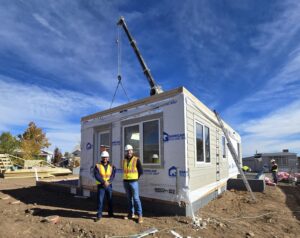This post is provided by Earthcore SIPs.
There are many conditions that determine the effectiveness of any building material to provide comfort and energy efficient performance. R-Value is only one of these factors or measurement tools.
R-Value is the measure of resistance to heat flow through the defined material. The higher the R-Value the less heat will transfer through the wall, making the system more energy efficient.
R-Value is determined by testing or by the addition of tested components. When “effective” R-value is used, it represents that at a given condition or circumstance, the system performs the same as a product with the “real” R-value.
It is important to understand the conditions at which the “effective” R-value was determined, and see if your application is the same. For example, a masonry wall may have a high “effective” R-value for a 5 hour test period, but have a very low R-value during a 24 hour test period. Where “real” R-value products will have the same R-value during both test periods.
There are several items to consider when evaluating R-Value and it’s effect on your project
Effective R-Value
An example would be masonry products. Masonry product have a very low R-Value but have a high thermal mass. Foam type products have a high R-value but low thermal mass. There is not a standard measurement or number for the energy effectiveness of thermal mass. While R-value resists the flow of heat, thermal mass delays the transfer of heat but does not reduce it. During a short period, thermal mass has the same “effective” R-value, so it is sometimes advertised with this R-value rating. It is not a real R-value but, under those conditions, an “effective” R-value. Please review other technical bulletins for more details and other related items.
Installed R-Value vs Advertised R-Value
It should be noted that R-Value of an item is the value that was tested in a laboratory and is real, but the item may not perform at the same R-value when installed. Most insulating materials obtain their insulating values from trapped air spaces, often the higher the density of air pockets, the higher the R-value. If these air spaces are compressed, a lower R-value will result. For example, batt type insulation may be rated at R-19 in its free state, but requires a 6 ½” thickness to obtain that value. When this material is installed in a 5 ½” frame cavity, the batt is compressed and the R-value is less than R-19. Likewise, putting two batts in the space for one does not increase insulating value; it might even reduce the R-value. Review the Technical Bulletin on Air Infiltration in Insulation for more related information.
Nonuniform Material
Whole wall R-value is the term used to describe the average R-value for the total wall taking into consideration variations and non-uniformity’s in the insulating material. Often, the R-value of the insulating material is advertised without stating the effect of the total system.
An example would be installing an R-19 batt insulation in a 2×6 frame wall. The resultant “whole wall R-value” is the average of the R-19 insulation and the R-5 stud. Tests have shown that the actual “whole wall R-value” of an R-19 wall system to be R-13.7, much less than the R-19 advertised. This applies to all non uniform wall systems.
The R-value of building materials may be effected or altered by the following items.
- Non uniform material
- Thermal shorts
- Material compression
- Air infiltration in the insulation
- Humidity
- Temperature swing or range of environment
- Effects of time and aging.
Along with R-Value, several other factors need to be considered to determine the overall energy efficiency of a building structure.
- Thermal Mass
- Air infiltration in the building
- Radiated heat gains
- Internal heat gains
- Latent and Sensible heat transfer











2 thoughts on “Understanding R-Value and Insulation”
Hi Barbara,
Thanks for your comment. You may find a recent post about open vs. closed cell foams relevant: https://evstudio.com/thermal-envelope-open-cell-vs-closed-cell-foam-insulation/
Also, while we avoid plumbing in exterior walls in cold climates, when it is absolutely necessary, it is critical to have insulation so that the pipes are on the warm side of the wall. This still is not a failsafe plan (on those -20 degree streches like we had a few weeks back), but is certainly a minimum requirement. With that, the closed cell foam would be the best approach in order to maximize the R-value available in the remainder of the wall.
Best of luck!
-Dean
As a Realtor in Massachusetts, I am often asked my opinion on various insulating-related issues. Not being licensed to comment in this field, I often refer my clients to web information sources and I certainly will use this site! Thank you for a very complete explanation of R value! There is quite a conversation here going on about open v. Closed cell blown in insulation and I’d love to get your take on this as well. By the way, I also have a home in the Wash Park neighborhood. Having just suffered an almost complete loss down to the studs due to burst water pipes, I would love to hear your opinions about using Icynene between outer walls and pipes! Many thanks for this article,
Barbara Miller
Comments are closed.